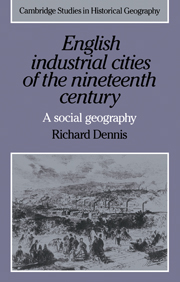Book contents
- Frontmatter
- Contents
- List of Figures
- List of Tables
- Preface
- A note on prices and distances
- 1 Urban geography and social history
- 2 Sources of diversity among Victorian cities
- 3 Contemporary accounts of nineteenth-century cities
- 4 Public transport and the journey to work
- 5 The geography of housing
- 6 Class consciousness and social stratification
- 7 The spatial structure of nineteenth-century cities
- 8 Residential mobility, persistence and community
- 9 Community and interaction
- 10 The containing context
- Notes
- Bibliography
- Index
8 - Residential mobility, persistence and community
Published online by Cambridge University Press: 05 January 2010
- Frontmatter
- Contents
- List of Figures
- List of Tables
- Preface
- A note on prices and distances
- 1 Urban geography and social history
- 2 Sources of diversity among Victorian cities
- 3 Contemporary accounts of nineteenth-century cities
- 4 Public transport and the journey to work
- 5 The geography of housing
- 6 Class consciousness and social stratification
- 7 The spatial structure of nineteenth-century cities
- 8 Residential mobility, persistence and community
- 9 Community and interaction
- 10 The containing context
- Notes
- Bibliography
- Index
Summary
An investigation of residential mobility forms a convenient bridge between discussions of ecological structure and community. Residential mobility is the mechanism whereby the character of social areas is maintained or changed, and social areas provide the context in which individuals make decisions about their residential location and subsequent mobility. But mobility, or its opposite, persistence, is also used as an indicator of the stability of communities, and the distances over which the mobile move, the sources of their information, the vacancies they examine and the particular destinations they choose may all be used to define the geographical limits of community.
Contemporary observers assumed that a transient population was an uncontrollable and potentially dangerous population. You could not create a community out of constantly changing ingredients. Much the same assumption has lain behind twentieth-century discussions of working-class community, where it has been argued that a sense of community is a product of social and individual stability over time. Communities are most likely to exist where families have lived and worked in the same area for a long time, and where neighbours are also kin. Hence, it should be possible to assess the potential for community, if not its reality, by calculating the extent of residential stability and the frequency of kinship links between local residents. This line of reasoning has been criticised by those who identify community with class consciousness, or who have witnessed the rapid growth of community spirit in response to external threats. Michael Anderson has also expressed his scepticism of the assumption that persistence engenders community.
- Type
- Chapter
- Information
- English Industrial Cities of the Nineteenth CenturyA Social Geography, pp. 250 - 269Publisher: Cambridge University PressPrint publication year: 1984
- 1
- Cited by



